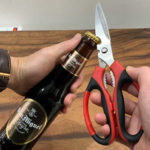Knitting is an intricate craft that requires a multitude of advanced techniques. If you’re interested in learning this skill, it’s essential to familiarize yourself with the necessary tools that will greatly facilitate your knitting journey.
1 Yarn
 Yarn
Yarn
First and foremost, the primary material for knitting is, of course, yarn. However, it’s important to pay attention to the type and size of yarn you choose.
Types of Yarn
Yarn can be made from a variety of materials such as nylon, plastic, acrylic fibers, wool, cotton, and lua, to name a few.
Most commonly, knitters use yarn made from cotton or a blend of acrylic fibers.
Thickness of Yarn
 Yarn thickness chart according to international standards
Yarn thickness chart according to international standards
When purchasing yarn, be sure to check the product description for information about the material and thickness. If this information is not available, don’t hesitate to contact the seller to ensure you get the right yarn for your project.
In Vietnam, the most commonly used yarns are cotton yarn (Lace #0) and milk cotton yarn (Light #3 or Medium #4).
Choosing the Right Yarn
The type of yarn you choose will depend on your project and the knitting needles you plan to use. Here’s a guide to help you select the appropriate yarn:
- Yarn #0 – Lace (Fingering, Size 10 Crochet Thread): Perfect for creating delicate lace patterns, scarves, or coasters.
- Yarn #1 – Super Fine (Sock, Fingering, Baby): Commonly used for socks, scarves, and baby clothing.
- Yarn #2 – Fine (Sport, Baby): Ideal for long-sleeved cardigans, socks, and scarves.
- Yarn #3 – Light (DK, Light Worsted): Specifically designed for knitting garments for adults and children.
- Yarn #4 – Medium (Worsted, Afghan, Aran): A great choice for beginners as it is easy to work with.
- Yarn #5 – Bulky (Chunky, Craft, Rug): Perfect for creating thick scarves, winter coats, rugs, or pillows due to its large stitches and quick knitting process.
- Yarn #6 – Super Bulky (Roving): Ideal for knitting hats and scarves.
 Yarn sizes
Yarn sizes
2 Knitting Needles
Another essential tool for knitters is a good set of knitting needles. There are various types of needles available, but if you’re just starting out, here are three types to consider:
Single-Pointed Needles
 Single-pointed needles
Single-pointed needles
Single-pointed needles come in different sizes, indicated by a number on the needle. It’s important to choose the right size needle for your yarn to achieve the desired result. Using a needle that’s too large will create large holes in your fabric, while a needle that’s too small can be difficult to work with and may result in missed stitches.
For beginners, it’s recommended to start with size 3 or 4 single-pointed needles.
Double-Pointed Needles
 Double-pointed needles
Double-pointed needles
Double-pointed needles typically have one end that is larger than the other, with two different sizes indicated on the needle. These needles are usually used by more experienced knitters.
Tunisian Hooks
 Tunisian hooks
Tunisian hooks
Tunisian hooks are similar to single-pointed needles but are longer in length. They are specifically designed for the Tunisian knitting technique.
3 Measuring Tape
 Measuring tape
Measuring tape
A measuring tape is crucial to ensuring your project turns out just right. Traditional tape measures can be cumbersome to use, so consider investing in a retractable tape measure for added convenience.
4 Scissors
 Scissors
Scissors
A good pair of scissors is essential for cutting yarn, trimming ends, and other tasks.
5 Stitch Markers
 Stitch markers
Stitch markers
Stitch markers come in various shapes, such as the letter “C” or a straight pin, but they all serve the same purpose—to mark your place in a pattern or indicate a specific stitch.
Stitch markers are invaluable tools for both beginners and experienced knitters alike.
6 Row Counters
 Row counters
Row counters
If you’re just starting out, consider investing in a row counter to keep track of your progress. It’s easy to get lost in your knitting and lose count of your rows, so a row counter can save you time and frustration.
7 Sewing Needles
 Sewing needles
Sewing needles
Sewing needles are a must-have for knitting stuffed toys. They are used to sew together different parts of the toy and give it a polished look.
With these tools in your knitting arsenal, you’ll be well on your way to becoming a proficient knitter in no time! Happy knitting!



































